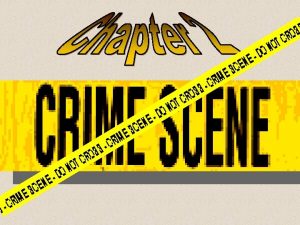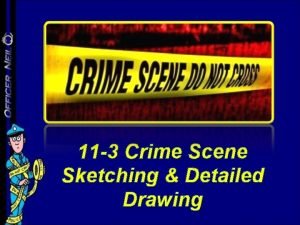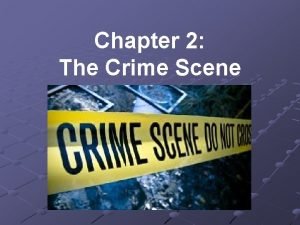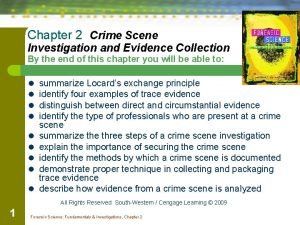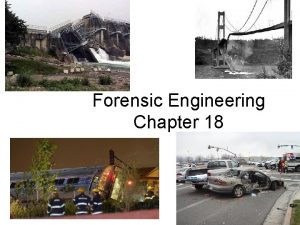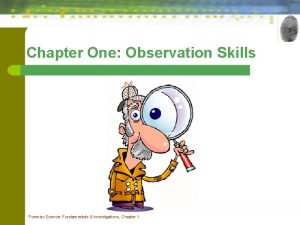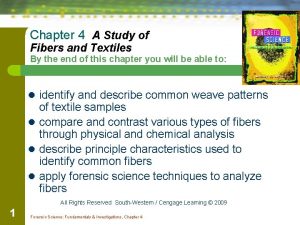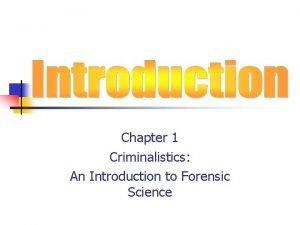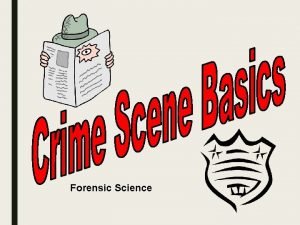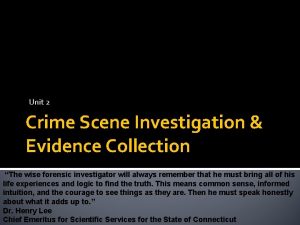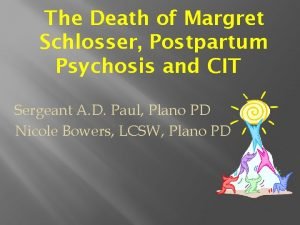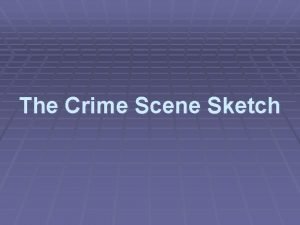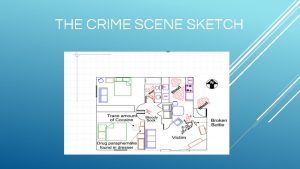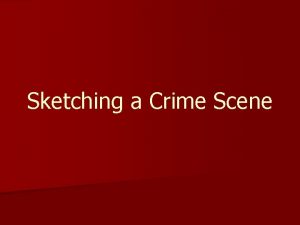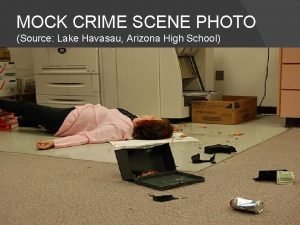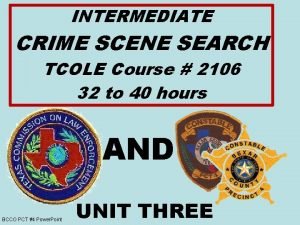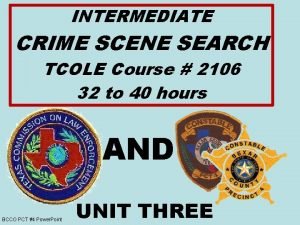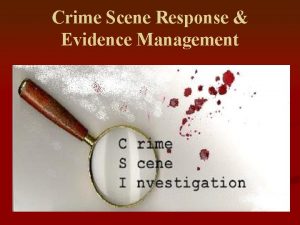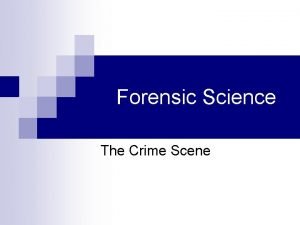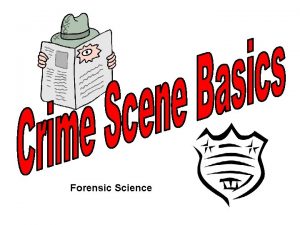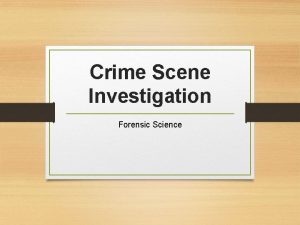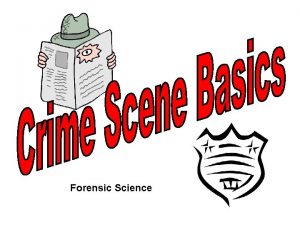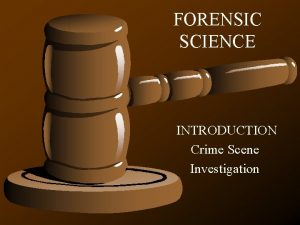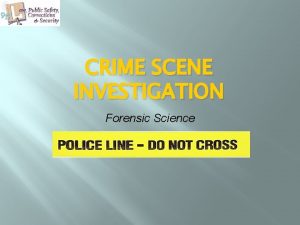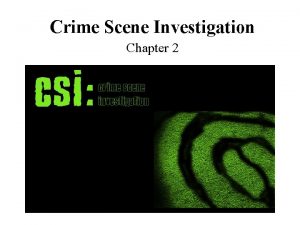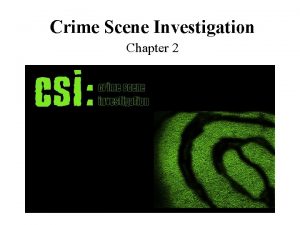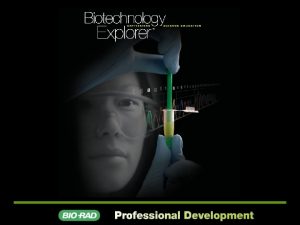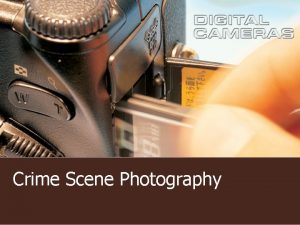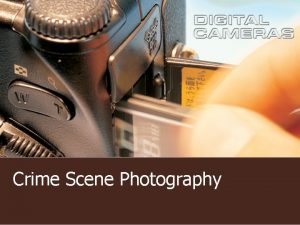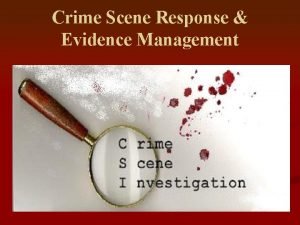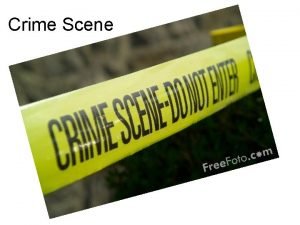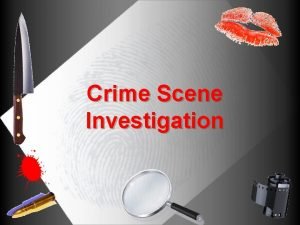Chapter 2 THE CRIME SCENE FORENSIC SCIENCE An































- Slides: 31

Chapter 2 THE CRIME SCENE FORENSIC SCIENCE An Introduction By Richard Saferstein PRENTICE HALL © 2008 Pearson Education, Inc. Upper Saddle River, NJ 07458 2 -1

Physical Evidence • As automobiles run on gasoline, crime laboratories “run” on physical evidence. • Physical evidence encompasses any and all objects that can establish that a crime has been committed or can provide a link between a crime and its victim or a crime and its perpetrator. • But if physical evidence is to be used effectively for aiding the investigator, its presence first must be recognized at the crime scene. FORENSIC SCIENCE An Introduction By Richard Saferstein PRENTICE HALL © 2008 Pearson Education, Inc. Upper Saddle River, NJ 07458 2 -2

The Beginning • Forensic science begins at the crime scene. • If the investigator cannot recognize physical evidence or cannot properly preserve it for laboratory examination, no amount of sophisticated laboratory instrumentation or technical expertise can salvage the situation. • Here, investigators must recognize and properly preserve evidence for laboratory examination. • It must be emphasized that the techniques of crime -scene investigation are not difficult to master and certainly lie within the bounds of comprehension of the average police officer. FORENSIC SCIENCE An Introduction By Richard Saferstein PRENTICE HALL © 2008 Pearson Education, Inc. Upper Saddle River, NJ 07458 2 -3

The First Steps • The first officer to arrive at the scene is responsible for securing the crime scene. • First priority should be given to obtaining medical assistance for individuals in need of it and to arresting the perpetrator. • As soon as it is possible, extensive efforts must be made to exclude all unauthorized personnel from the scene. • Once the scene is secured, the preliminary exam must begin. • Recording of the crime scene becomes a critical piece to the investigation process. FORENSIC SCIENCE An Introduction By Richard Saferstein PRENTICE HALL © 2008 Pearson Education, Inc. Upper Saddle River, NJ 07458 2 -4

Systematic Search FORENSIC SCIENCE An Introduction By Richard Saferstein • Thorough and systematic • No pertinent evidence can be overlooked. This will insure a factual and unbiased reconstruction of the crime. • Not necessary to have a forensic scientist present, unless, it is a major crime. • Advisable to have one person supervising and coordinating the collection of the evidence. • Physical evidence can be anything from massive objects to microscopic. PRENTICE traces. HALL © 2008 Pearson Education, Inc. Upper Saddle River, NJ 07458 2 -5

Systematic Search FORENSIC SCIENCE An Introduction By Richard Saferstein • Collect possible carriers of trace evidence: Clothing – Each piece of clothing must be wrapped separately. • Areas of the crime scene must be vacuumed so that the sweepings can be submitted to the lab for analysis. • Different sweepings from different areas must be packaged separately. • Fingernail scrapings from those individuals who were in contact might contain. PRENTICE minute fragments HALL Pearson Education, Inc. of evidence. © 2008 2 -6 Upper Saddle River, NJ 07458

Systematic Search FORENSIC SCIENCE An Introduction By Richard Saferstein • From the autopsy room – Cause and manner of death – Tissues and organs are retained for pathological and toxicological examinations • The following items are collected and sent to the forensic lab – Victim’s clothing – Fingernail scrapings – Head and pubic hairs – Blood (DNA Typing) – Vaginal, and oral swaps (Sexrelated crimes) – Recovered bullets – Hand swabs from shooting victims (gunshot residue analysis) PRENTICE HALL © 2008 Pearson Education, Inc. Upper Saddle River, NJ 07458 2 -7

Bell Ringer • Identify three things that are important when securing a crime scene and explain why FORENSIC SCIENCE An Introduction By Richard Saferstein PRENTICE HALL © 2008 Pearson Education, Inc. Upper Saddle River, NJ 07458 2 -8

Take no more than 6 hours Posted Sentry with Access roster Re-route parking lot cars & Students Crime Scene 7 8 FORENSIC SCIENCE An Introduction By Richard Saferstein 5 6 Close two lanes of traffic, open other two, but make them 1 PRENTICE way HALL © 2008 Pearson Education, Inc. Upper Saddle River, NJ 07458 2 -9

4 1 2 3 FORENSIC SCIENCE An Introduction By Richard Saferstein PRENTICE HALL © 2008 Pearson Education, Inc. Upper Saddle River, NJ 07458 2 -10

Recording Methods • Photography, sketches, and notes are three methods for crime-scene recording. • Ideally all three should be employed; however, as is often the case, personnel and monetary limitations may prohibit the utilization of photography at every crime site. FORENSIC SCIENCE An Introduction By Richard Saferstein PRENTICE HALL © 2008 Pearson Education, Inc. Upper Saddle River, NJ 07458 2 -11

Photography • The most important prerequisite for photographing a crime scene is for it to be in an unaltered condition. • Unless there are injured parties involved, objects must not be moved until they have been photographed from all necessary angles. • As items of physical evidence are discovered, they are photographed to show their position and location relative to the entire scene. • After these overviews are taken, close-ups should be taken to record the details of the object itself. – When the size of an item is of significance, a ruler or other measuring scale may be inserted near the object and included in the photograph as a point of reference. FORENSIC SCIENCE An Introduction By Richard Saferstein PRENTICE HALL © 2008 Pearson Education, Inc. Upper Saddle River, NJ 07458 2 -12

Sketches • Once photographs are taken, the crime-scene investigator will sketch the scene. • Rough Sketch—A draft representation of all essential information and measurements at a crime scene. This sketch is drawn at the crime scene. It shows all recovered items of physical evidence, as well as other important features of the crime scene. • Finished Sketch—A precise rendering of the crime scene, usually drawn to scale. This type is not normally completed at the crime scene. • Unlike the rough sketch, the finished sketch is drawn with care and concern for aesthetic appearance. FORENSIC SCIENCE An Introduction By Richard Saferstein PRENTICE HALL © 2008 Pearson Education, Inc. Upper Saddle River, NJ 07458 2 -13

Sketches--Details Prepare a Diagram/Sketch of Scene • Sketches and photographs compliment your field notes, they do not replace them. They refresh your memory of the event and they provide a permanent record of the incident. Distances are best documented by creating rough drawings or sketches with all the significant dimensions accurately recorded. – a) The diagram establishes a permanent record of; items, conditions and distance/size relationships. Diagrams supplement photographs. – b) A rough sketch is drawn at scene and changes may not be made once you have left the scene. – c) Number designations on sketch should be coordinated with same number designations on the evidence log. – d) The sketch should contain sufficient measurements and detail to be used as a model for a drawn-to-scale, or smooth, diagram, if necessary. FORENSIC SCIENCE An Introduction By Richard Saferstein PRENTICE HALL © 2008 Pearson Education, Inc. Upper Saddle River, NJ 07458 2 -14

Sketches--Details e) Be sure to select a sketch technique before beginning the sketch— insure that enough room is allowed to include all pertinent information. f) Accurate and consistent measurements must be taken before the evidence is collected. Triangulate for exact distance. Use the lowest scale on the ruler/tape that you use for taking the measurements. The measurements should be recorded on a separate piece of paper, the key or legend, rather than on the rough sketch itself. (1) Straight Line - Measurements are taken from fixed points to either side of the object. (2) Rectangular Coordinates – The Baseline technique is the simplest form of the rectangular coordinate system. Using a straight line between two known points, items are measured along the line and perpendicular from the line. Inside or outside of a house, this line can be a straight wall. Outdoor scenes can use a string or long measuring tape as the reference or base line. (3) Triangulation - Measurements are taken from two fixed points to point on the item as to create an imaginary triangle. This is usually done from two or more points on the evidentiary item. FORENSIC SCIENCE An Introduction By Richard Saferstein PRENTICE HALL © 2008 Pearson Education, Inc. Upper Saddle River, NJ 07458 2 -15

Sketches--Details • (1) Title block that contains, at a minimum: – – – (a) Case number (b) Exact location (c) Date and Time (d) Person preparing the sketch and all those who assisted. (e) Compass orientation (North arrow) • (2) Key or legend containing – – (a) Evidence is represented by numbers (DO NOT USE I and O) (b) Fixed points and large objects, represented by letter (c) Measurements (d) Other symbols used such as: • (i) Direction of stairway • (ii) Direction a door opens • h) General Progression of Sketches: • Do not overcrowd the sketch with nonessential items or details. The rough sketch may also be required to be produced at the trial. • Remember, you must complete the rough sketch and all necessary corrections before leaving the crime scene. FORENSIC SCIENCE An Introduction By Richard Saferstein PRENTICE HALL © 2008 Pearson Education, Inc. Upper Saddle River, NJ 07458 2 -16

Notes • Note taking must be a constant activity throughout the processing of the crime scene. • These notes must include a detailed written description of the scene with the location of items of physical evidence recovered. • They must identify: – – the time an item of physical evidence was discovered. by whom. how and by whom it was packaged and marked. the disposition of the item after it was collected. • The note taker has to keep in mind that this written record may be the only source of information for refreshing one’s memory. FORENSIC SCIENCE An Introduction By Richard Saferstein PRENTICE HALL © 2008 Pearson Education, Inc. Upper Saddle River, NJ 07458 2 -17

Recording the Crime Scene • Investigators have only a limited amount of time to work a crime site in its untouched state. • The opportunity to permanently record the scene in its original state must not be lost. • Such records will not only prove useful during the subsequent investigation but are also required for presentation at a trial in order to document the condition of the crime site and to delineate the location of physical evidence. • Every step of the investigation should be documented thoroughly with an appropriate method. FORENSIC SCIENCE An Introduction By Richard Saferstein PRENTICE HALL © 2008 Pearson Education, Inc. Upper Saddle River, NJ 07458 2 -18

The Preliminary Exam • A lead investigator will start the process of evaluating the area. – First, the boundaries of the scene must be determined – Followed by the establishment of the perpetrator’s path of entry and exit. – The investigator then proceeds with an initial walkthrough of the scene to gain an overview of the situation and develop a strategy for the systematic examination and documentation of the entire crime scene. • This is done before processing the crime scene for physical evidence. FORENSIC SCIENCE An Introduction By Richard Saferstein PRENTICE HALL © 2008 Pearson Education, Inc. Upper Saddle River, NJ 07458 2 -19

The Search • The search for physical evidence at a crime scene must be thorough and systematic. • The search pattern selected will normally depend on the size and locale of the scene and the number of collectors participating in the search. • For a factual, unbiased reconstruction of the crime, the investigator, relying upon his or her training and experience, must not overlook any pertinent evidence. • Physical evidence can be anything from massive objects to microscopic traces. FORENSIC SCIENCE An Introduction By Richard Saferstein PRENTICE HALL © 2008 Pearson Education, Inc. Upper Saddle River, NJ 07458 2 -20

The Search • Often, many items of evidence are clearly visible but others may be detected only through examination at the crime laboratory. • For this reason, it is important to collect possible carriers of trace evidence, such as clothing, vacuum sweepings, and fingernail scrapings, in addition to more discernible items. FORENSIC SCIENCE An Introduction By Richard Saferstein PRENTICE HALL © 2008 Pearson Education, Inc. Upper Saddle River, NJ 07458 2 -21

Beyond the Crime Scene • The search for physical evidence must extend beyond the crime scene to the autopsy room of a deceased victim. • Here, the medical examiner or coroner will carefully examine the victim to establish a cause and manner of death. • As a matter of routine, tissues and organs will be retained for pathological and toxicological examination. • At the same time, arrangements must be made between the examiner and investigator to secure a variety of items that may be obtainable from the body for laboratory examination. FORENSIC SCIENCE An Introduction By Richard Saferstein PRENTICE HALL © 2008 Pearson Education, Inc. Upper Saddle River, NJ 07458 2 -22

Beyond The Crime Scene • The following are to be collected and sent to the forensic laboratory: 1. Victim’s clothing 2. Fingernail scrapings 3. Head and pubic hairs 4. Blood (for DNA typing purposes) 5. Vaginal, and oral swabs (in sexrelated crimes) 6. Recovered bullets from the body 7. Hand swabs from shooting victims (for gunshot residue analysis) FORENSIC SCIENCE An Introduction By Richard Saferstein PRENTICE HALL © 2008 Pearson Education, Inc. Upper Saddle River, NJ 07458 2 -23

Packaging • Each different item or similar items collected at different locations must be placed in separate containers. Packaging evidence separately prevents damage through contact and prevents cross-contamination. • The well-prepared evidence collector will arrive at a crime scene with a large assortment of packaging materials and tools ready to encounter any type of situation. FORENSIC SCIENCE An Introduction By Richard Saferstein PRENTICE HALL © 2008 Pearson Education, Inc. Upper Saddle River, NJ 07458 2 -24

Packaging • Forceps and similar tools may have to be used to pick up small items. • Unbreakable plastic pill bottles with pressure lids are excellent containers for hairs, glass, fibers, and various other kinds of small or trace evidence. • Alternatively, manila envelopes, screw-cap glass vials, or cardboard pillboxes are adequate containers for most trace evidence encountered at crime sites. • Ordinary mailing envelopes should not be used as evidence containers because powders and fine particles will leak out of their corners. FORENSIC SCIENCE An Introduction By Richard Saferstein PRENTICE HALL © 2008 Pearson Education, Inc. Upper Saddle River, NJ 07458 2 -25

Packaging • Small amounts of trace evidence can also be conveniently packaged in a carefully folded paper, using what is known as a “druggist fold. ” • Although pill bottles, vials, pillboxes, or manila envelopes are good universal containers for most trace evidence, two frequent finds at crime scenes warrant special attention. • If bloodstained materials are stored in airtight containers, the accumulation of moisture may encourage the growth of mold, which can destroy the evidential value of blood. • In these instances, wrapping paper, manila envelopes, or paper bags are recommended packaging materials. FORENSIC SCIENCE An Introduction By Richard Saferstein PRENTICE HALL © 2008 Pearson Education, Inc. Upper Saddle River, NJ 07458 2 -26

Chain of Custody • Chain of Custody—A list of all persons who came into possession of an item of evidence. • Continuity of possession, or the chain of custody, must be established whenever evidence is presented in court as an exhibit. • Adherence to standard procedures in recording the location of evidence, marking it for identification, and properly completing evidence submission forms for laboratory analysis is critical to chain of custody. • This means that every person who handled or examined the evidence and where it is at all times must be accounted for. FORENSIC SCIENCE An Introduction By Richard Saferstein PRENTICE HALL © 2008 Pearson Education, Inc. Upper Saddle River, NJ 07458 2 -27

Obtaining Reference Samples • Standard/Reference Sample—Physical evidence whose origin is known, such as blood or hair from a suspect, that can be compared to crimescene evidence. • The examination of evidence, whether it is soil, blood, glass, hair, fibers, and so on, often requires comparison with a known standard/reference sample. • Although most investigators have little difficulty recognizing and collecting relevant crime-scene evidence, few seem aware of the necessity and importance of providing the crime lab with a thorough sampling of standard/reference materials. FORENSIC SCIENCE An Introduction By Richard Saferstein PRENTICE HALL © 2008 Pearson Education, Inc. Upper Saddle River, NJ 07458 2 -28

Special Forensic Science Services • Forensic Pathology involves the investigation of unnatural, unexplained, or violent deaths. – Forensic pathologists in their role as medical examiners or coroners are charged with determining cause of death. – The forensic pathologist may conduct an autopsy which is the medical dissection and examination of a body in order to determine the cause of death. FORENSIC SCIENCE An Introduction By Richard Saferstein PRENTICE HALL © 2008 Pearson Education, Inc. Upper Saddle River, NJ 07458 2 -29

Special Forensic Science Services • After a human body expires there are several stages of death. – Rigor mortis results in the shortening of muscle tissue and the stiffening of body parts in the position at death (occurs within the first 24 hrs. and disappears within 36 hrs. ). – Livor mortis results in the settling of blood in areas of the body closest to the ground (begins immediately on death and continues up to 12 hrs. ). – Algor mortis results in the loss of heat by a body (a general rule, beginning about an hour after death, the body loses heat by 1 to 1 1/2 degrees Fahrenheit per hour until the body reaches the environmental temperature). FORENSIC SCIENCE An Introduction By Richard Saferstein PRENTICE HALL © 2008 Pearson Education, Inc. Upper Saddle River, NJ 07458 2 -30

Special Forensic Science Services • Forensic Anthropology is concerned primarily with the identification and examination of human skeletal remains. • Forensic Entomology is the study of insects and their relation to a criminal investigation, commonly used to estimate the time of death. FORENSIC SCIENCE An Introduction By Richard Saferstein PRENTICE HALL © 2008 Pearson Education, Inc. Upper Saddle River, NJ 07458 2 -31
 Forensic science begins at the
Forensic science begins at the Legend crime scene sketch
Legend crime scene sketch Druggist fold steps
Druggist fold steps Locard exchange principle
Locard exchange principle Thomas mocker and thomas stewart
Thomas mocker and thomas stewart Forensic psychiatry vs forensic psychology
Forensic psychiatry vs forensic psychology Forensic science chapter 18 review answers
Forensic science chapter 18 review answers Unscented trajectory chapter 17
Unscented trajectory chapter 17 Chapter 14 forensic anthropology
Chapter 14 forensic anthropology Why are observation skills important in forensics
Why are observation skills important in forensics Chapter 6 fingerprints
Chapter 6 fingerprints Chapter 4 fibers and textiles
Chapter 4 fibers and textiles Chapter 1 intro to forensic science
Chapter 1 intro to forensic science Father of bloodstain identification. *
Father of bloodstain identification. * Crime scene investigation vocabulary
Crime scene investigation vocabulary Forensic science chapter 1
Forensic science chapter 1 My favorite subject is english because
My favorite subject is english because Robin hood hills crime scene photos
Robin hood hills crime scene photos Seven s of crime scene
Seven s of crime scene Types of crime scene
Types of crime scene Margaret schlosser autopsy photos
Margaret schlosser autopsy photos Final sketch crime scene
Final sketch crime scene Exploded/cross projection sketch
Exploded/cross projection sketch What must be included on a crime scene sketch
What must be included on a crime scene sketch Crime scene factoring and quadratic functions answer key
Crime scene factoring and quadratic functions answer key Rough sketch crime scene
Rough sketch crime scene Mock crime scene scenarios
Mock crime scene scenarios Tcole crime scene investigation
Tcole crime scene investigation Tcole 2106 course
Tcole 2106 course Crime scene factoring and quadratic functions answer key
Crime scene factoring and quadratic functions answer key Cross-projection sketch
Cross-projection sketch Crime scene photography management
Crime scene photography management
